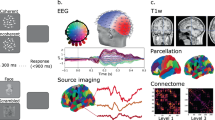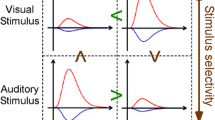Abstract
Functional magnetic resonance imaging (FMRI) and event related potentials (ERPs) are tools that can be used to image brain activity with relatively good spatial and temporal resolution, respectively. Utilizing both of these methods is therefore desirable in neuroimaging studies to explore the spatio-temporal characteristics of brain function. While several studies have investigated the relationship between EEG and positive (+) BOLD (activation), little is known about the relationship between EEG signals and negative (−) BOLD (deactivation) responses. In this study, we used a visual stimuli designed to shift cortical activity from anterior to posterior regions of the visual cortex. Using EEG and FMRI, we investigated how shifts in +BOLD and −BOLD location were correlated to shifts in the N75 and P100 visual evoked potential (VEP) dipolar sources. The results show that the N75 dipole along with +BOLD, were indeed shifted from posterior to anterior regions of the visual cortex. The P100 VEP component, along with the −BOLD were not shifted to the same extent, indicating that N75 is better correlated to +BOLD than to −BOLD. These findings indicate how different components of the EEG signal are related to the positive and negative BOLD responses, which may aid in interpreting the relationship between visually evoked EEG and FMRI signals.
Similar content being viewed by others
References
Ahlfors SP et al (1992) Estimates of visually evoked cortical currents. Electroencephalogr Clin Neurophysiol 82(3):225–236
Bressler D et al (2007) Negative BOLD fMRI response in the visual cortex carries precise stimulus-specific information. PLoS ONE 2:e410
Chen CC et al (2005) Lateral modulation of BOLD activation in unstimulated regions of the human visual cortex. Neuroimage 24(3):802–809
Clark V et al (1995) Identification of early visual evoked potential generators by retinotopic and topographic analyses. Hum Brain Mapp 2:170–187
Cox RW (1996) AFNI: software for analysis and visualization of functional magnetic resonance neuroimages. Comput Biomed Res 29(3):162–173
Di Russo F et al (2003) Source analysis of event-related cortical activity during visuo-spatial attention. Cereb Cortex 13(5): 486–499
Di Russo F et al (2005) Identification of the neural sources of the pattern-reversal VEP. Neuroimage 24(3):874–886
Dougherty RF et al (2003) Visual field representations and locations of visual areas V1/2/3 in human visual cortex. J Vis 3(10): 586–598
Glover GH (1999) Simple analytic spiral K-space algorithm. Magn Reson Med 42(2):412–415
Gomez Gonzalez CM et al (1994) Sources of attention-sensitive visual event-related potentials. Brain Topogr 7(1):41–51
Ha KS et al (2003) Optimized individual mismatch negativity source localization using a realistic head model and the Talairach coordinate system. Brain Topogr 15(4):233–238
Ikeda H et al (1998) Generators of visual evoked potentials investigated by dipole tracing in the human occipital cortex. Neuroscience 84(3):723–739
Im CH et al (2007) Spatial resolution of EEG cortical source imaging revealed by localization of retinotopic organization in human primary visual cortex. J Neurosci Methods 161(1):142–154
Janz C et al (2001) Coupling of neural activity and BOLD fMRI response: new insights by combination of fMRI and VEP experiments in transition from single events to continuous stimulation. Magn Reson Med 46(3):482–486
Kaneoke Y (2006) Magnetoencephalography: in search of neural processes for visual motion information. Prog Neurobiol 80(5): 219–240
Kashikura K et al (2001) Temporal characteristics of event-related BOLD response and visual-evoked potentials from checkerboard stimulation of human V1: a comparison between different control features. Magn Reson Med 45(2):212–216
Kobayashi E et al (2006) Negative BOLD responses to epileptic spikes. Hum Brain Mapp 27:488–497
Meredith JT et al (1982) Pattern-reversal visual evoked potentials and retinal eccentricity. Electroencephalogr Clin Neurophysiol 53(3):243–253
Nakamura M et al (2000) Effects of check size on pattern reversal visual evoked magnetic field and potential. Brain Res 872(1–2): 77–86
Odom JV et al (2004) Visual evoked potentials standard (2004). Doc Ophthalmol 108(2):115–123
Schroeder CE et al (1991) Striate cortical contribution to the surface-recorded pattern-reversal VEP in the alert monkey. Vision Res 31(7–8):1143–1157
Shigeto H et al (1998) Visual evoked cortical magnetic responses to checkerboard pattern reversal stimulation: a study on the neural generators of N75, P100 and N145. J Neurol Sci 156(2):186–194
Shmuel A et al (2006) Negative functional MRI response correlates with decreases in neuronal activity in monkey visual area V1. Nat Neurosci 9(4):569–577
Shmuel A et al (2002) Sustained negative BOLD, blood flow and oxygen consumption response and its coupling to the positive response in the human brain. Neuron 36(6):1195–1210
Singh M et al (2003) Correlation between BOLD-fMRI and EEG signal changes in response to visual stimulus frequency in humans. Magn Reson Med 49(1):108–114
Slotnick SD et al (1999) Using multi-stimulus VEP source localization to obtain a retinotopic map of human primary visual cortex. Clin Neurophysiol 110(10):1793–1800
Smith AT et al (2000) Attentional suppression of activity in the human visual cortex. NeuroReport 11(2):271–277
Smith AT et al (2004) Negative BOLD in the visual cortex: evidence against blood stealing. Hum Brain Mapp 21(4):213–220
Tootell RB et al (1998) The representation of the ipsilateral visual field in human cerebral cortex. Proc Natl Acad Sci U S A 95(3):818–824
Whittingstall K et al (2006) Evaluating the spatial relationship of event-related potential and functional MRI sources in the primary visual cortex. Hum Brain Mapp 28(2):134–142
Acknowledgments
This work was funded by the Natural Sciences and Engineering Research Council of Canada (NSERC). The authors would like to thank Christine Dyck and Greg McLean for their assistance with the EEG and FMRI measurements. Special thanks also go to C. Petkov for his helpful comments.
Author information
Authors and Affiliations
Corresponding author
Additional information
An erratum to this article can be found at http://dx.doi.org/10.1007/s10548-008-0073-2
Rights and permissions
About this article
Cite this article
Kevin, W., Doug, W., Matthias, S. et al. Correspondence of Visual Evoked Potentials with FMRI Signals in Human Visual Cortex. Brain Topogr 21, 86–92 (2008). https://doi.org/10.1007/s10548-008-0069-y
Received:
Accepted:
Published:
Issue Date:
DOI: https://doi.org/10.1007/s10548-008-0069-y




